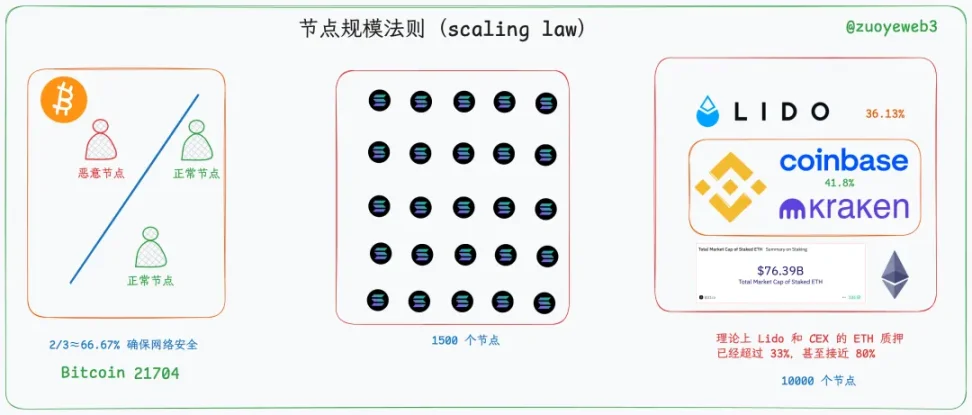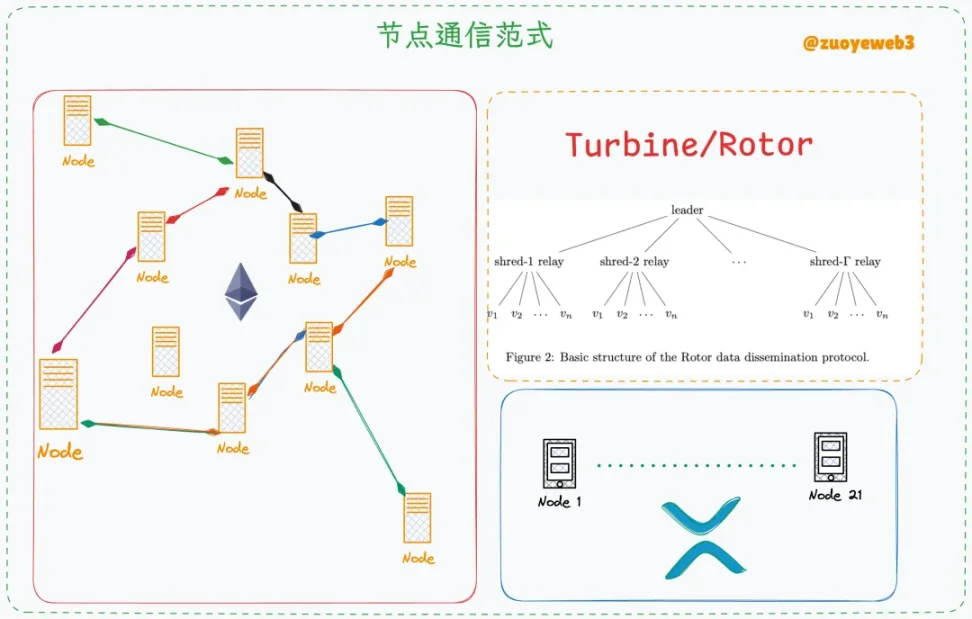The ultimate dream of Ethereum is to be a world computer, and coincidentally, so is Alpenglow.
Written by: Zuo Ye
Ethereum has begun supply-side reform.
After the dream of an infinite garden shattered, Vitalik has constrained the human debt of L2/Rollup, taking a more proactive stance to defend the L1 track. The Ethereum mainnet's "speeding up and reducing costs" plan is now on the agenda. The shift to Risc-V is just the beginning; how to catch up with or even surpass Solana in efficiency will become the main focus going forward.
Solana continues to expand consumption demand scenarios.
Solana's answer is "Scale or Die," steadfastly pursuing the path of strengthening L1. In addition to the Firedancer developed by Jump Trading entering the deployment process, at this New York Solana conference, the Anza team's Alpenglow consensus protocol took the lead, attracting everyone's attention.
The ultimate dream of Ethereum is to be a world computer, and coincidentally, so is Alpenglow.
20% Security Consensus in the Era of Large-Scale Nodes
Since Bitcoin, the number and dispersion of nodes have been synonymous with measuring the decentralization of blockchain networks. To avoid centralization, the security threshold is set at 33%, meaning no single entity should exceed this proportion.
With the boost of capital efficiency, Bitcoin mining has ultimately led to mining pool clusters, while Ethereum has become the main stage for Lido and CEX. Of course, this does not mean that mining pools and Lido can control network operations; under the "maintain the network - earn incentives/management fees" model, they have no motive to do harm.

Image caption: Blockchain node scale law, image source: @zuoyeweb3
However, to measure the health of a network, its scale must be considered. For example, in a small group of 3 people, a 2/3 majority is needed for effective operation. Simply pursuing the minimum security guarantee of 1/3 is meaningless; the remaining two can easily collude, making the cost of wrongdoing very low while the benefits are substantial.
If it is a large-scale network of 10,000, as Etherscan indicates for Ethereum's current node scale, there is no need to pursue a 2/3 majority. Beyond the incentive model, most nodes do not know each other, and the coordination cost for collusion between Lido and Binance is too high.
If we reduce both the number of nodes and the consensus ratio, can we "speed up and reduce costs"?
Everyone should be able to think that Alpenglow is also considering this and is preparing to do so, maintaining Solana's scale of 1,500 nodes while reducing the security consensus to 20%. This can increase node confirmation speed, earn more mainnet incentives for nodes, and encourage the expansion of node scale, potentially swelling to around 10,000.
Whether this results in a 1+1>2 effect or breaches the existing security mechanism could happen.
However, I quite like it; Solana should pursue the American chain, conspiracy groups, and centralization routes, participating in public chain competition as Ethereum's opposite.
Modifying Turbine or Moving Towards DPoS
The theoretical approach of Alpenglow is that the era of large-scale nodes does not require a strong consensus quantity because, under the PoS mechanism, wrongdoers need to mobilize vast amounts of capital to gain control. Even at a scale of 20%, based on current prices, Ethereum would need $20 billion, and Solana would need $10 billion.
With $10 billion, why would anyone want to control a blockchain? It would be madness, and they would also face retaliation from the remaining 80% of nodes, unless it is state-sponsored.
In practice, Alpenglow roughly divides the entire process into three parts: Rotor, Votor, and Repair (for more detailed divisions and workflows, refer to their paper). To some extent, Alpenglow is a deep modification of the Turbine mechanism, so let’s briefly introduce Turbine.

Image caption: Block broadcasting mechanism, image source: @zuoyeweb3
Turbine is Solana's block propagation mechanism. Simply put, Turbine is the messenger that spreads block information to achieve consensus confirmation across all nodes.
In the early design of Ethereum, block broadcasting was done through the Gossip protocol, which in Chinese means "rumor" or "hearsay." Any node could act as an initial messenger and communicate P2P with any other node, ultimately achieving network-wide confirmation, akin to "I have a message, I’ll only tell you, and you must not tell anyone else," until the whole world knows.
Let’s temporarily skip Turbine and compare it with Ripple's DPOS mechanism. Ethereum/Bitcoin have achieved extreme point-to-point communication, but what is the cost?
It is extreme slowness and expense, which is easy to understand. Random pairings of nodes without purpose will be more robust and resistant to censorship, but will take longer. The expense comes from the cost of nodes, as the slow propagation of information from other nodes requires them to pass on costs to users in the form of Gas Fees.
Extreme decentralization inevitably leads to the accompanying issues of being both expensive and slow.
Ripple's DPOS goes to the other extreme, initially setting only 21 supernodes across the network, completely solving any side effects through extreme centralization. The number of mainnet nodes has now reached 179.
Turbine, on the other hand, moves towards a middle state, neither adopting Ethereum's Gossip mechanism nor reducing the number of nodes. Instead, it implements a hierarchical propagation of network nodes:
In each cycle, nodes are divided into Leader, Relay, and more ordinary nodes, with only Leader nodes allowed to send block broadcast information.
A small number of Relay nodes accept the information and continue to broadcast it to more ordinary nodes. This process is called the Turbine Tree, resembling a tree with clear hierarchies.
In Alpenglow, this protocol variant is called Rotor, which essentially involves orderly propagation of block messages, with any Leader or Relay node being non-fixed.
Votor is the node confirmation mechanism. For example, in Alpenglow's vision, if the first round of node voting reaches an 80% ratio, meeting the minimum of over 20%, it can be quickly passed. If the first round of voting is above 60% but below 80%, a second round of voting can be initiated, and if it exceeds 60% again, it can be confirmed.
If that still doesn't work, then the Repair mechanism is invoked. However, I feel this is similar to the challenge period of Optimistic Rollup; if it reaches this point, the protocol is likely to fail. The FDIC cannot prevent a bank run like that of Silicon Valley Bank.
Unlike violently stacking hardware and software resources to increase bandwidth, Alpenglow's starting point is to reduce the block consensus generation process.
If data blocks are kept as small as possible, say around 1,500 Bytes, and the generation time is kept short enough—currently, in testing, it can reach extreme cases of 100ms, which is 1% of the current 10s (1 s = 1000 ms; however, this is questionable, as in large-scale practical use, conditions may not be so ideal, but it is still quite terrifying).
Conclusion
After MegaETH, existing L2s have basically reached their endpoint. With SVM L2 not receiving support from Solana, there is a practical need for the Solana mainnet to continue expanding. Only by achieving overwhelming TPS on the mainnet can the concept of Solana as Ethereum's killer be fully realized.
Alpenglow can also be applied beyond Solana; theoretically, any PoS chain, including Ethereum, can use its mechanism. Similar to what we previously introduced with Optimum, existing blockchain research has reached the edge of technology and urgently needs more help from computer science and even sociological concepts.
IBM once claimed that the future of the world only needs five mainframes. If the internet formed by HTTP-TCP/IP is one, BTC is one, and Ethereum is one, then there is not much space left for Solana.
免责声明:本文章仅代表作者个人观点,不代表本平台的立场和观点。本文章仅供信息分享,不构成对任何人的任何投资建议。用户与作者之间的任何争议,与本平台无关。如网页中刊载的文章或图片涉及侵权,请提供相关的权利证明和身份证明发送邮件到support@aicoin.com,本平台相关工作人员将会进行核查。




